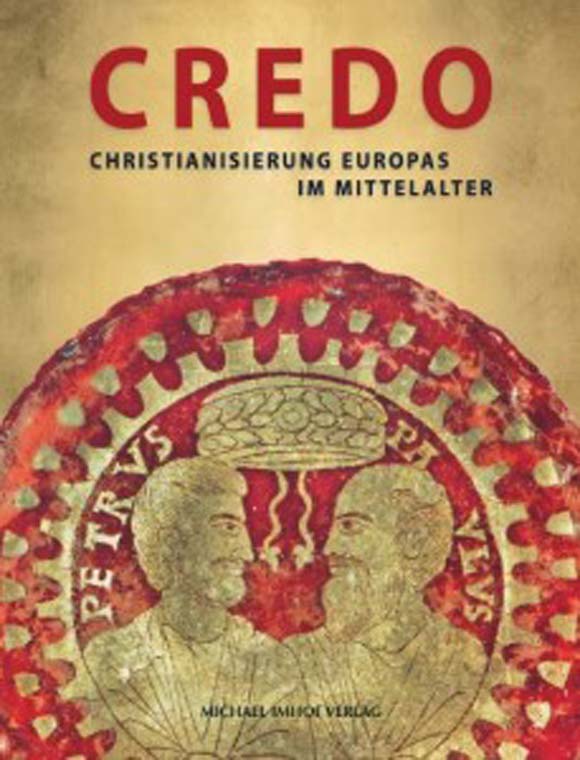
Credo exhibition in Paderborn
1.17k
 |
| Credo: The Christianisation of Medieval Europe |
Although he rejected worldly power (Jn 18:36), Christ is the true King over all the nations (cf. Rom 15:12), the King of Kings (Rev. 17:14). On this great feast of Christ the King, it seems relevant to reflect on the way in which Christianity has spread to incorporate the different cultures of the nations. Here is one part of the story, the evangelisation of Europe, as told in a remarkable exhibition earlier this year: Credo – The Christianisation of Medieval Europe.
Europe is the Faith and the Faith is Europe. This famous statement by Hilaire Belloc is wrong in many ways – if the Faith is Catholic, how can it be purely European? – but it touches upon a fundamental historical fact. The Catholic faith is built upon a series of extraordinary events on the edges of Europe that subsequently, and apparently against all odds, dominated the Roman Empire and built an entire civilisation, what we call ‘Christendom’, on European soil. How this remarkable story unfolded was the subject of a major exhibition in Paderborn earlier this year, entitled Credo: The Christianisation of Medieval Europe.
Paderborn was an apposite location. This has long been a strongly Catholic city in North Rhine-Westphalia; it was an Imperial city under Charlemagne, and refuge for Pope Leo III; and in recent years has mounted two other great medieval exhibitions (‘Charlemagne 799’, and ‘Canossa 1077’). I travelled from Oxford to see this Credo exhibition (and visit family in the area), having been alerted by an article in the Tablet. The exhibition was impressive for its impressive variety of treasures and artefacts, from the Mediterranean to Greenland, over more than a millennium of fascinating history. The depth of coverage was superb. But, above all, the exhibition told a compelling story.
That story began with the inculturation of Christianity from its very beginnings. In Part 1: Lux Mundi, visitors were treated to objects, both ordinary and precious, that revealed a two-way process of adaptation. Christianity had to adopt and appropriate pagan symbols and practices, but in turn transformed them in radical ways and left a new mark on the wider culture. Pagan notions of the vita felix (happy life), pastoral scenes of good shepherding, and so on, were quickly seen in a newly Christian light. And yet Christianity was unusual, almost unique, in rejecting the polytheistic cults of the Roman Empire. A beautiful papyrus of Romans 8:27-35, dating from the 2nd century(!), was one of the first marvels to greet us, testifying to the great faith of the early Christians in the face of persecution: If God is for us, who can be against us?
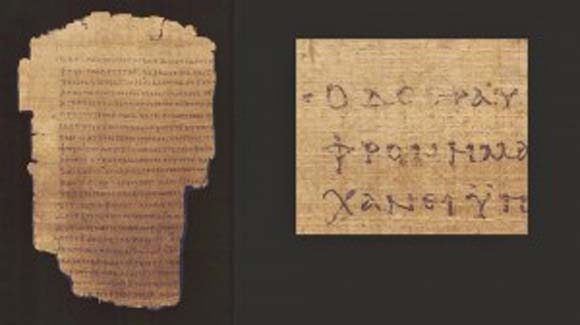 |
| 2nd-century papyrus of Romans 8 |
Three centuries later, however, Christianity had become tolerated and promoted after Constantine’s conversion in 312. After his vision of the Christian symbol ‘Chi-Rho’ (short for ‘Christ’) and subsequent victory at the Milvian bridge, Christianity came fully out of the shadows. But only with the edict Cunctos Populos, issued by the Three Emperors in 380, did it become the official state religion. The great Ecumenical Councils (on which, see our Godzdogz series Councils of Faith) hammered out the doctrinal structure of Trinitarian faith and a great outpouring of theological and spiritual works came from the mouths and quills of the ancient Church Fathers. The exhibition included the oldest Latin manuscript of the Bible (5th century) and early copies of St Jerome and St Augustine. These classical scholars and saints witnessed the terrible decline of the Roman Empire and looked instead to the Catholic Church to preserve all that was best in it. Rome was ‘the brightest light in the world’; and ‘if Rome perishes’, asked Jerome, ‘what is safe?’
This much is incontrovertible, that the Church preserved much of the ancient learning in its monasteries from the barbarian onslaught. Through the Church, this civilisation of ideas permeated to the farthest corners of the Empire: I saw one copy of Pliny’s Natural History from Northumbria. After Augustine’s mission to England, familiar to a man of Kent like me, there followed the less well-known story of Canterbury’s blossoming into a major centre of manuscript illumination. One magnificent specimen on show was the Codex Aureus (‘golden book’) with its alternately purple-dyed pages.
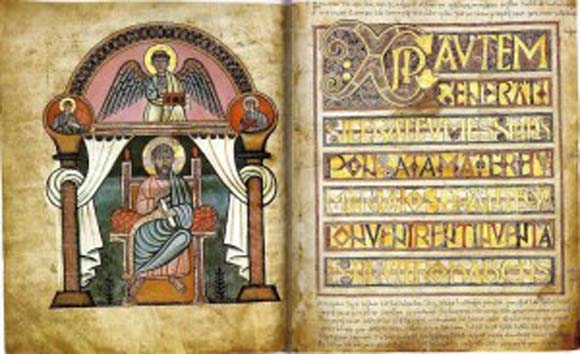 |
| The Codex Aureus of Canterbury |
Britain, indeed, saw a marked inculturation that showed great ingenuity in the adaptation of pagan customs to Christian belief. Triangular plaques typical of pagan votive offerings would be inscribed with Christian emblems, as found among the Water Newton treasure. Among the priceless objects of this hoard, I saw what are believed to be the oldest liturgical silver vessels in the Christian world. And in the royal tomb at Prittlewell, discovered only in 2003, gold crosses had been placed over the dead man’s eyes, where pagans would have put coins. As far as I could see, the exhibition did not mention the Green Man motif, which is so typical of Christian inculturation in pagan Britain. But it did have an intriguing gold medallion in Animal Style II, from 7th century France, showing the Cross and the Alpha/Omega signs embedded in an obviously pagan aesthetic.
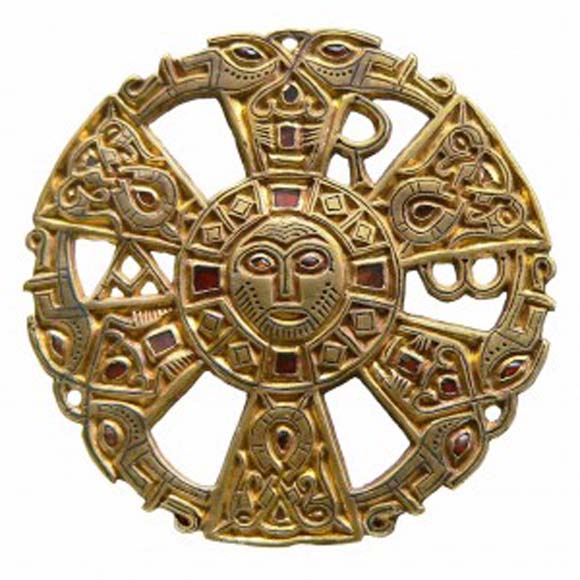 |
| The gold medallion of Limons |
After the collapse of Rome, a most remarkable thing happened. The faith that had spread to the edges of civilised Europe now began to trickle back, through the missions of zealous Irish and British monks. The Northumbrian St. Willibrord became the ‘apostle to the Frisians’ (i.e. the Netherlands) and founded Echternach Abbey (Luxembourg) in the 8th century. This roaming archbishop got much use out of his exquisitely carved portable altar, which was on display. A similar relic, the ‘Cadmug Gospel’ in Irish minuscule lettering, belonged to St Boniface on his missions to the German peoples. St Columbanus the Younger took twelve companions from Ireland and converted the Frankish nobility, founding many monasteries along the way, including Bobbio as far south as Italy. St Ansgar, born in northern France, became the ‘apostle to the North’ after being sent by the Emperor Louis the Pious to evangelise Scandinavia; he baptised the Danish king Harald Klak in 826, two centuries before the saint-king, Olaf Haraldsson, would abandon his career as a Viking raider and enlist English clergy to bring Christianity to the remote reaches of Norway.
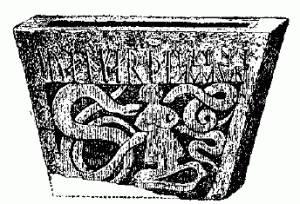 |
| King Gunnar in the snake-pit |
Throughout this period, Christianity learned to adopt the semiotic references of the pagan world. In Scandinavia, the old runes were very common in Christian art. But it was also the symbolic content that penetrated the culture. These pagan appropriations are not entirely coherent and harmonious. To take one example, a rectangular baptismal font (Sweden, c.1100 AD) portrays the semi-mythical king Gunnar in the snake pit as a sort of holy protomartyr; but in Norway, Sigurd the Dragon-slayer is shown on a 12th-century church portal as a prefiguration of Christ. Unfortunately, this juxtaposition is a little awkward if the Nibelungenlied is anything to go by, in which Gunnar (Gunther) conspires in Sigurd’s (Siegfried’s) murder!
The evangelisation of Europe was not always an easy or happy process. Part 2 of Credo, entitled In Hoc Signo, besides describing the Eastern missions of Saints Cyril and Methodius and showcasing the riches of Byzantium, also focused on the more political aspects of Christianisation. Emperor Charlemagne forced the Saxons to the font, offering them ‘baptism or death’. The missions to Scandinavia coincided with the formation of its kingdoms and the Church’s fortunes often oscillated according to the whims of kings. Prophetic voices abounded, of course, and I was impressed with Alcuin of York’s bold objection to Charlemagne that Christians should be ‘preachers, not plunderers’.
Europe did adopt the Faith, and the Faith owes much to its European cradle. But the story does not end there. Sadly, more plundering was to follow with the colonisations of the New World; and again there were protests from prophetic preachers, such as Bartolomeo de las Casas OP. In the present day, the Church has reached the ends of the earth and continues to incorporate and enrich the cultures of the nations. The kingdom of God may not be of this world, but the gospel of Christ is certainly for this world. In our confused and conflict-ridden situations, it may be hard to believe in the kingship of Christ. But the faith of the missionaries that was made so tangible by this Credo exhibition is still alive and flourishing, and it calls us to be new bearers of light to the dark and barbarous corners of the world – including Oxford.
 |
| Christ the King |


